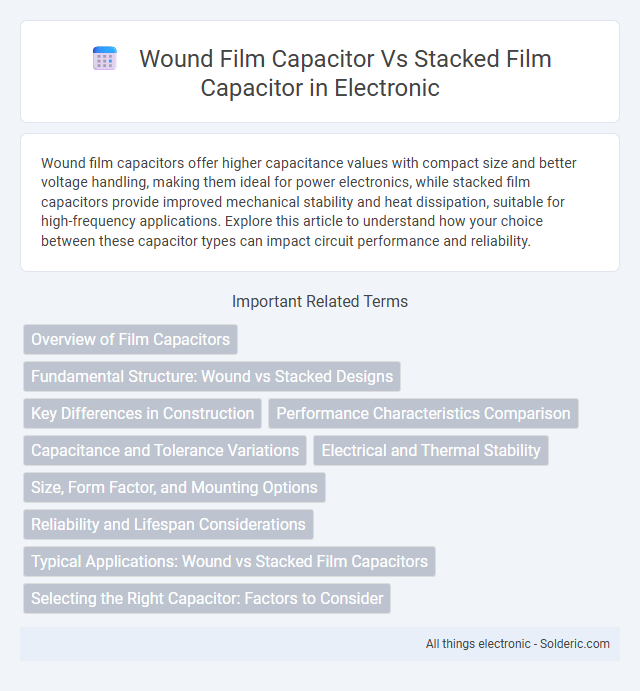Wound film capacitors offer higher capacitance values with compact size and better voltage handling, making them ideal for power electronics, while stacked film capacitors provide improved mechanical stability and heat dissipation, suitable for high-frequency applications. Explore this article to understand how your choice between these capacitor types can impact circuit performance and reliability.
Comparison Table
| Feature | Wound Film Capacitor | Stacked Film Capacitor |
|---|---|---|
| Construction | Thin film wound around a cylindrical core | Multiple film layers stacked in a flat configuration |
| Size | Compact, cylindrical shape | Flat, rectangular or square shape |
| Capacitance Range | Low to medium capacitance (pF to uF) | Medium to high capacitance (nF to uF) |
| Voltage Rating | Typically lower voltage rating (up to a few kV) | Higher voltage rating due to stacked layers |
| Dielectric Loss | Generally low dielectric loss | Very low dielectric loss, suitable for precision applications |
| Frequency Performance | Good high-frequency performance | Excellent high-frequency response with reduced inductance |
| Reliability | Good reliability in general applications | Higher reliability for demanding environments |
| Applications | Power electronics, filtering, coupling | Precision filtering, timing circuits, high-frequency applications |
Overview of Film Capacitors
Wound film capacitors consist of a dielectric film wound tightly around a cylindrical core, providing compact size and excellent high-frequency performance, making them ideal for RF and pulse applications. Stacked film capacitors use multiple dielectric film layers stacked together to enhance capacitance and voltage rating, offering superior stability and reliability in power electronics. Your choice depends on specific application requirements such as voltage, capacitance, size, and frequency response.
Fundamental Structure: Wound vs Stacked Designs
Wound film capacitors consist of dielectric film and metal foil layers tightly rolled into a cylindrical shape, providing a compact form factor and uniform electric field distribution. Stacked film capacitors are made by layering multiple film and electrode sheets in a flat, stacked arrangement, allowing for higher volumetric efficiency and improved capacitance per unit volume. The fundamental structural difference influences performance characteristics such as ripple current handling, thermal dissipation, and frequency response.
Key Differences in Construction
Wound film capacitors consist of dielectric film layers tightly rolled into a cylindrical shape, enabling compact design and high capacitance per volume. Stacked film capacitors, on the other hand, are constructed by layering flat dielectric films and electrodes in a planar stack, which allows for improved mechanical stability and better heat dissipation. The rolled geometry of wound capacitors typically provides a higher volumetric efficiency, while the stacked design facilitates enhanced electric field control and reduced equivalent series resistance (ESR).
Performance Characteristics Comparison
Wound film capacitors offer higher reliability and better insulation properties due to their uniform dielectric layering, resulting in lower equivalent series resistance (ESR) and improved high-frequency performance. Stacked film capacitors provide greater capacitance density and smaller size but may exhibit slightly higher ESR and reduced thermal stability under heavy load conditions. The choice between wound and stacked film capacitors depends on application requirements such as frequency response, ripple current handling, and space constraints.
Capacitance and Tolerance Variations
Wound film capacitors typically exhibit tighter tolerance ranges, commonly around +-5% to +-10%, due to their precision winding process, whereas stacked film capacitors often have wider tolerance variations, ranging from +-10% to +-20%. Capacitance values in wound film capacitors tend to be more stable and precise, making them preferable for applications requiring high accuracy and reliability. In contrast, stacked film capacitors can achieve higher capacitance values in a more compact form but at the expense of increased tolerance deviations and potential capacitance drift over time.
Electrical and Thermal Stability
Wound film capacitors exhibit superior electrical stability due to their uniform dielectric layer and precise winding technique, minimizing dielectric losses and enhancing voltage endurance. Stacked film capacitors offer improved thermal stability by efficiently dissipating heat through their compact, layered structure, reducing the risk of thermal degradation under high current loads. Both capacitor types maintain reliable performance in high-frequency applications, with wound film capacitors excelling in voltage stability and stacked film capacitors in heat management.
Size, Form Factor, and Mounting Options
Wound film capacitors typically offer a smaller size and cylindrical form factor, making them ideal for compact applications with radial or axial lead mounting options. Stacked film capacitors present a flat, rectangular shape that supports surface-mount technology (SMT) and is preferred for high-density circuit boards where space optimization is critical. Both types differ significantly in mounting versatility, with wound capacitors suited for through-hole mounting while stacked capacitors excel in automated SMT assembly processes.
Reliability and Lifespan Considerations
Wound film capacitors typically offer excellent reliability due to their precise winding process, which minimizes internal stress and enhances electrical stability. Stacked film capacitors, on the other hand, provide improved thermal management and mechanical robustness, contributing to a longer lifespan in high-vibration or high-temperature environments. When selecting between the two, your application's reliability requirements and expected operating conditions will determine the optimal capacitor type for sustained performance.
Typical Applications: Wound vs Stacked Film Capacitors
Wound film capacitors are commonly used in power electronics, audio equipment, and filtering applications due to their high reliability and excellent pulse handling capabilities. Stacked film capacitors excel in compact electrical circuits, such as automotive systems and consumer electronics, where space-saving and higher capacitance density are crucial. Your choice depends on whether you prioritize durability and pulse performance (wound) or size efficiency and capacitance in limited space (stacked).
Selecting the Right Capacitor: Factors to Consider
When selecting between wound film capacitors and stacked film capacitors, consider factors such as capacitance stability, voltage rating, and physical size to match your application's performance needs. Wound film capacitors typically offer better pulse handling and higher voltage capabilities, while stacked film capacitors provide compactness and lower equivalent series resistance (ESR). Your decision should balance these parameters with thermal stability and reliability requirements to optimize circuit efficiency.
wound film capacitor vs stacked film capacitor Infographic

 solderic.com
solderic.com